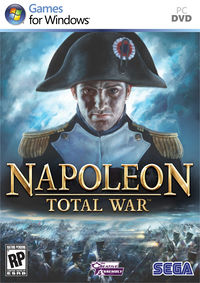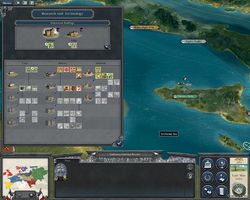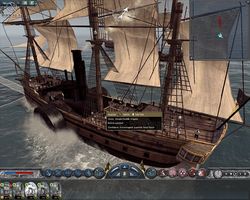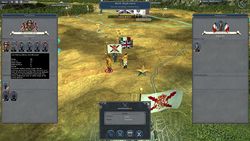Difference between revisions of "Napoleon: Total War"
| Line 114: | Line 114: | ||
*Moscow Musketeers - Russia: Smarter than your average musketeer, this elite regiment of battle-hardened Russians is able to unleash a deadly hail of bullets and follow it up with a deadly charge only Mother Russia could produce. | *Moscow Musketeers - Russia: Smarter than your average musketeer, this elite regiment of battle-hardened Russians is able to unleash a deadly hail of bullets and follow it up with a deadly charge only Mother Russia could produce. | ||
| + | ====Imperial Guard Pack==== | ||
| + | The Imperial Guard Pack features 6 brand new units and contains an alternative version of the Battle of Waterloo, fought from the British perspective. | ||
| + | |||
| + | =====The Battle of Waterloo Alternative version===== | ||
| + | |||
| + | Napoleon had the feeling he had won the war as he advanced towards the Anglo-Dutch army at Waterloo. The Prussians were retreating, pursued by a French corps, and only Wellington remained. French armies would be victorious once again, and the Empire would be reborn in fire. But the history book on the shelf would not be repeating itself… | ||
| + | |||
| + | This alternative version includes: | ||
| + | •Britain as the playable faction. | ||
| + | •Two of the new units from the Imperial Guard Pack are included in the battle | ||
| + | •The French have more troops meaning that the battle is balanced differently. | ||
| + | |||
| + | =====Units Included===== | ||
| + | *Polish Guard Lancers: Nothing is more frightening than a Pole with a lance; it might be the Czpaka, or it might be the sharpness of the lance, either way these deadly cavalrymen are ideal for hunting down the Enemies of the Empire. | ||
| + | *Dutch Guard Lancers: Originally Hussars, these men were trained by the fearsom Polish Lancers in the closely guarded secrets of the way of the lance and should not be underestimated on the battlefield. | ||
| + | *Guard Chasseurs à Cheval: Napoleon’s closest guards, they had their origins on the battlefields of northern Italy and the “Guides” that Napoleon raised there. When the regiment was officially constituted in 1800 it had four officers and 113 men, all chosen from among the Guides and other veterans of the Italian campaign. Napoleon’s respect for his regiment was obvious and he was often seen wearing the green undress uniform of the chasseurs. These men followed Napoleon from Arcola to Waterloo, and remained loyal to him even in his exile. Now that's dedication! | ||
| + | *Dutch Grenadiers: The Dutch Grenadiers became part of Napoleon’s army following his 1810 annexation of Holland. At that time they were the Dutch Royal Grenadiers, and the men of this regiment entered Paris in August of 1810. Napoleon reviewed the troops personally and was very impressed by the fine appearance of the men. They wear white coats faced with crimson, instead of the traditional dark blue worn by other senior regiments. | ||
| + | *Guard Seamen: Despite initial chortels due to their name, these elite soldiers are a force to be reckoned with. They were originally intended for action as part of the planned invasion of Britain, but when these plans were put aside they took a place in the Imperial Guard. In a few short years these men had developed a wide variety of skills that made them indispensible to the Emperor. He commented that "When occasion required they proved equally valuable whether as sailors, soldiers, artillerymen or engineers; there was no duty they could not undertake." | ||
| + | *Empress Dragoons: Under Napoleon the Imperial Guard gradually became an almost separate army; it had infantry, artillery, and cavalry components, and even its own elite units within the already-elite Guard. By any standards, the Empress Dragoons, named to honour Josàphine de Beauharnais, were an elite force. All the officers were appointed personally by Napoleon, and the rankers had to have served at least 10 years in the saddle before they were allowed to join. Every chasseur and dragoon regiment of the line in the French army had its best non-commissioned officers taken. While this undoubtedly made sure the Empress Dragoons was composed of the best of the best, it almost certainly damaged the rest of the army by removing those same veterans from their original units. | ||
Revision as of 22:00, 9 April 2011
Contents
Napoleon: Total War was released on the 23rd of February, 2010. The Peninsular Campaign DLC was released on the 22nd of June, 2010. Both were developed by the Creative Assembly and published by SEGA.
Aside from the Peninsular Campaign, two more DLC packs were released: Coalition Battle Pack and the Imperial Guard Pack
Overview
Napoleon: Total War is set during the extremely turbulent and violent Napoleonic Era, from 1805 - 1815. Set at a time when revolutionary France is turning the old dynasties of europe upside down, old rivalries and mistrusts will be put aside to halt the amibitions of one man and the rise of a european superpower: France.
Napoleons Italian campaign highlights his struggles against the mighty Austrian empire and her friends in Italy, where management and efficiency is vital. The Egyptian campaign brings a different challenge all together, Napoleon must fight his way up through the Mamelukes and deal with constant nuisance raids from the British in order to achieve his goal. And then the Russian Bear presents a new challenge with her climate, even the best general will struggle to avoid the cold and push through. Patience and cunning will be needed here.
Napoleon: Total War also gives the player a chance to play as one of four Coalition powers: Great Britain, Austria, Prussia or Russia. The effort to stop Napoleon and his new regieme will require all the tactical and strategic genius the Allied powers can muster.
| Total War Series |
|---|
|
Total War: Three Kingdoms - Portal Total War Saga: Thrones of Britannia Medieval II: Total War - Portal |
This game also brings some revolutionary new features to the Total War series. Creative Assembly has introduced a new system called Attrition. Attrition areas are scattered through the various campaign maps and will drastically effect your campaign if not considered when planning. Troops entering these 'attrition areas' will be effected by the weather and will quickly lose troop numbers during the Winter or Summer months depending on the type. As well as new systems CA has improved systems from Empire: Total War such as diplomacy. The player now has a greater range of diplomatic actions, such as asking a Faction to issue a trade embargo against another faction, or to join you in a war against another faction.
General Information
- Napoleon: Total War could be considered the easiest Total War game to pick up so far, as it's well oiled and tested systems are easy to use by a new player.
- Napoleon: Total War took an already revolutionary system and made it better, with a far superior campaign and battle AI, plus a wider range of available options
- The game is set during the Napoleonic Era, allowing more advanced weaponry to be researched
Campaigns
The Napoleon Campaigns differ greatly from the Grand campaigns of [[[Empire: total War]]], being much smaller maps, yet much more graphically appealing. Napoleon: total War offers several differentcampaigns that let you take command and lead your armies on land and sea over Italy, Egypt and gain the Mastery of Europe as Napoleon. Alternatively, you can play as an enemy of the Empire in one of the Campaigns of the Coalition and establish your own dominance over Europe.
The trade nodes feature from Empire: Total War is still existant, however they lie on the outer edges of the map, rather than different theatres. The Trade nodes included go to several different american ports, such as Boston, New York, and Savannah, as well as Indian ports like Calcutta, and various ports along the Barbary coast where your nation can recieve a variety of extra goods such as tobacco, spices, tea, and cotton which are all necessary should you wish to expand as an industrial power and field an army large enough to conquer Europe.
The Napoleon map is also now divided into 74 regions all in Europe. For example, France is no longer two provinces, but is not divided into the central French province, and Brittany, Normandy, Champagne, Alsace, Aquitaine, and Pays D'Oc. This, coupled with the two week turn time, allows for better campaigns, without the "Blitzkrieg" of Empire: Total War
Overall, the Napoleon: Total War campaign map is well suited for the focus of the game and is a beautiful representation of Europe.
There are also Two other maps, one of Italy and one of Egypt, which can be played in the Napoleon Campaign as you follow Yound Napoleon through his early days as a general fighting Austrians in "The shade of Olive trees", and Ottomans in the "Land of Pharoahs and Kings".
- -See main article: Napoleon: Total War Campaigns
Factions
- -See main article: Napoleon: Total War Factions
There are more than 35 Factions in NTW, but only a small amount are actually playable in the vanilla game. 18 factions are available to play with easy modding, or by using an already released mod.
Playable Factions
- Austria - Catholic Absolute Monarchy
- France - Catholic Empire
- Great Britain - Protestant Constitutional Monarchy
- Prussia -Protestant Absolute Monarchy
- Russia - Orthodox Absolute Monarchy
Unplayable Factions
- Spain
- Portugal
- Kingdom of Sicily
- Kingdom of Naples
- Papal States
- Kingdom of Italy
- Kingdom of Sardinia
- The Ottoman Empire
- Swiss confederation
- Bavaria
- Baden-Würtenberg
- Hessen - Kassel
- Batavian Republic
- Saxony
- Mecklenburg
- Denmark
- Sweden
- Oldenburg
Emergent Factions
- Scotland
- Ireland
- Hannover
- Belgium
- Brittany
- Catalonia
- Italy
- Hungary
- Greater Poland
- Normandy
- Courland
- Norway
- Greece
- Westfalen-Cleves
- Romania
- Crimean Khanate
- United Netherlands
Guides and strategy tips
Downloadable Content
Elite Regiments
A collection of 5 of the most elite military Forces of the Napoleonic Wars, from all the major European factions. They proved their bravery, discipline and excellence in key battles and will dramatically expand the player's strategic options on the battlefield.
Units Included
- 5e Regiment de Hussards - France: Light and fast, these veterans of the American War of Independence can quickly reach areas of the battlefield where they are most needed, cutting down the enemy with their curved sabres.
- Pavlograd Hussars - Russia: All hussars have "dash" and a touch of derring-do in their collective attitude towards war. Pavlograd hussars are, without exception, excellent horsemen, ideal for chasing down skirmishers and overrunning artillery units.
- 8th Life Regiment - Prussia: The steadiness displayed by the men of the 8th Life Regiment is amazing, and on the battlefield they will encourage nearby troops to follow their example. As with many Prussian line infantry units, these men are incredibly disciplined and trained.
- 47th (Czech) Regiment - Austria: These veteran soldiers are adept at close and fire combat. When formed in a disciplined line, they can unleash a massed volley of fire and then move forwards to engage in melee with the enemy.
- 88th Foot "Connaught Rangers" - Great Britain: A little rough around the edges, but courageous and professional on the battlefield, the Connaught Rangers are an Irish line infantry regiment. Whether pushing home a bayonet or forming a disciplined firing line, these men will stand and fight.
Heroes of the Napoleonic Wars
The "Heroes of the Napoleonic Wars" pack gathers the most superb infantry and cavalrymen who fought during the great Napoleonic battles: 10 exclusive units, which will all make a difference during key engagements, whether using formidable weapons or exceptional tactical skills.
Units Included
- 7th Lancers - France: These cavalrymen are armed with lances that make them particularly deadly when charging. The lance allows the user to put all his weight, and that of his charging horse, behind one very sharp point. Especially effective against enemy heavy cavalry
- Brandenburg Uhlans - Prussia: Without a doubt Prussia's best horsemen, able to use the best of speed, agility, and the long, sharp lances in their hands.
- 1st Hussars - Austria: All the benefits of Hussars with added Eliteness, the First Hussars are able to chase down fleeing enemies, as well as capture enemy artillery quick and effectively, with added Roleplay!
- 15th Hussars - Great Britain: Beteran cavalrymen, these Hussars are the best horsemen Britain can muster.
- 1st East Prussian Grenadier Battalion - Prussia: Need massive and muscular men to storm the enemy fortress? Have no fear, for the 1st East Prussian Grenadiers are here. Nothing says "Victory" like the strongest, bravest men in your country walking through the Arc de Tromph!
- 6th Regiment d'Infanterie Légère - France: Some of the bravest men in France, they participated in over 40 battles, and won seven honors for their action. They served the Emperor well, and now they are ready to serve you!
- 17th Jäger Regiment - Russia: The cream of Russian light infantry; able to weaken the enemy from afar, these Jaegers are just what your army needs!
- 1st Regiment Emperor's Own - Austria: Excellent marksmen and skilled butchers, what more could you ask from the "Emperor's Own"?
- 18th Regiment d'Infanterie de Ligne "The Brave" - France: Experienced and Brave: the perfect combination for European Domination
- Moscow Musketeers - Russia: Smarter than your average musketeer, this elite regiment of battle-hardened Russians is able to unleash a deadly hail of bullets and follow it up with a deadly charge only Mother Russia could produce.
Imperial Guard Pack
The Imperial Guard Pack features 6 brand new units and contains an alternative version of the Battle of Waterloo, fought from the British perspective.
The Battle of Waterloo Alternative version
Napoleon had the feeling he had won the war as he advanced towards the Anglo-Dutch army at Waterloo. The Prussians were retreating, pursued by a French corps, and only Wellington remained. French armies would be victorious once again, and the Empire would be reborn in fire. But the history book on the shelf would not be repeating itself…
This alternative version includes: •Britain as the playable faction. •Two of the new units from the Imperial Guard Pack are included in the battle •The French have more troops meaning that the battle is balanced differently.
Units Included
- Polish Guard Lancers: Nothing is more frightening than a Pole with a lance; it might be the Czpaka, or it might be the sharpness of the lance, either way these deadly cavalrymen are ideal for hunting down the Enemies of the Empire.
- Dutch Guard Lancers: Originally Hussars, these men were trained by the fearsom Polish Lancers in the closely guarded secrets of the way of the lance and should not be underestimated on the battlefield.
- Guard Chasseurs à Cheval: Napoleon’s closest guards, they had their origins on the battlefields of northern Italy and the “Guides” that Napoleon raised there. When the regiment was officially constituted in 1800 it had four officers and 113 men, all chosen from among the Guides and other veterans of the Italian campaign. Napoleon’s respect for his regiment was obvious and he was often seen wearing the green undress uniform of the chasseurs. These men followed Napoleon from Arcola to Waterloo, and remained loyal to him even in his exile. Now that's dedication!
- Dutch Grenadiers: The Dutch Grenadiers became part of Napoleon’s army following his 1810 annexation of Holland. At that time they were the Dutch Royal Grenadiers, and the men of this regiment entered Paris in August of 1810. Napoleon reviewed the troops personally and was very impressed by the fine appearance of the men. They wear white coats faced with crimson, instead of the traditional dark blue worn by other senior regiments.
- Guard Seamen: Despite initial chortels due to their name, these elite soldiers are a force to be reckoned with. They were originally intended for action as part of the planned invasion of Britain, but when these plans were put aside they took a place in the Imperial Guard. In a few short years these men had developed a wide variety of skills that made them indispensible to the Emperor. He commented that "When occasion required they proved equally valuable whether as sailors, soldiers, artillerymen or engineers; there was no duty they could not undertake."
- Empress Dragoons: Under Napoleon the Imperial Guard gradually became an almost separate army; it had infantry, artillery, and cavalry components, and even its own elite units within the already-elite Guard. By any standards, the Empress Dragoons, named to honour Josàphine de Beauharnais, were an elite force. All the officers were appointed personally by Napoleon, and the rankers had to have served at least 10 years in the saddle before they were allowed to join. Every chasseur and dragoon regiment of the line in the French army had its best non-commissioned officers taken. While this undoubtedly made sure the Empress Dragoons was composed of the best of the best, it almost certainly damaged the rest of the army by removing those same veterans from their original units.
Peninsular Campaign
The game takes place in the beginning of the 19th century, in the Iberian Peninsula. It's focused on the conflict between the British Army lead by Arthur Wellesley, Duke of Wellington and the French forces lead by Joseph Bonaparte. You can also embrace the crown of Spain in its struggle to preserve independence.
Gameplay features
- The main feature of the Campaign is guerrilla warfare: when you liberate a city, you get a few guerrilla units from the Spanish Resistance.
- There are three types of non-combat strategic units: propagandists, priests and rakes. The latter serve as assassins, spies and saboteurs.
- You can boost your economy and enlarge your income by sending a trade ship to one of your colonies.
- Technological researches also play an important role in the Peninsular Campaign.
Factions
Playable factions
- British Empire
- French Empire
- Spain
Non-playable factions
- Portugal
Guides and strategy tips
System Requirements
Minimal Requirements: Supported OS: Windows® XP Service Pack 2 or Windows Vista™ or Windows 7™ Processor: 2.4 GHz Intel® Pentium® or greater or AMD® Athlon® equivalent CPU, with SSE2 instruction Memory: 1 GB RAM (XP,) 2 GB RAM (Vista™) Graphics: 100% DirectX 9.0c compatible hardware accelerated video card with shader version 2.0 support, 256 MB video memory Display: Minimum screen resolution of 1280 x 1024 pixels Sound: Directx9.0c compatible sound card Hard Drive: 15 GB free hard disk space formatted as NTFS Peripherals: Windows compatible mouse and keyboard
Recommended Requirements: Supported OS: Windows® XP Service Pack 2 or Windows Vista™ or Windows 7™ Processor: 2.4 GHz Intel® Core 2 Duo® or greater or AMD® Athlon64® equivalent CPU, with SSE2 instruction Memory: 3 GB RAM (XP,) 4 GB RAM (Vista™) Graphics: 100% DirectX 9.0c compatible hardware accelerated video card with shader version 3.0 support, 512 MB video memory Display: Minimum screen resolution of 1280 x 1024 pixels Sound: Directx9.0c compatible sound card Hard Drive: 15 GB free hard disk space formatted as NTFS Peripherals: Windows compatible mouse and keyboard




